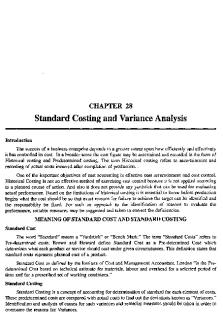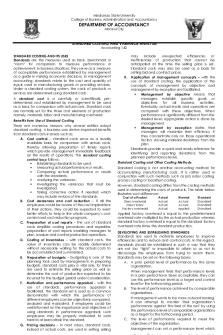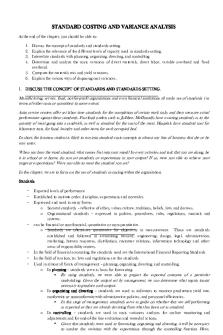8 Standard Costing & Variance Analysis PDF PDF

| Title | 8 Standard Costing & Variance Analysis PDF |
|---|---|
| Author | Olivia Williams |
| Course | Introduction to Accounting |
| Institution | University of Exeter |
| Pages | 3 |
| File Size | 160 KB |
| File Type | |
| Total Downloads | 48 |
| Total Views | 198 |
Summary
Download 8 Standard Costing & Variance Analysis PDF PDF
Description
8 Standard Costing & Variance Analysis Standard Costs Definition: The expected costs of that product/service. • Previously stated that while fixed costs and variable costs are regarded as being stable, often they are not. - The selling prices which have been calculated are based on these initial costs. - Changing costs means that profit margins are not what are expected. - Standard costing is a tool to examine the expected costs, profit and selling price of an item, based on numerous repetitions of production and sale. When product costing, inputs of direct material, direct labour, direct expenses and • indirect production overheads are allocated to products to determine a selling price so profit is made. • Since prices of inputs change rapidly, the costs of materials rises and falls depending on demand, wage rates etc which would be too time consuming to change all these prices daily or weekly. - This is why standard costing is necessary to accurately estimate what the cost of a product or service should be over a given period of time. • A standard cost card includes all the direct materials, labour, expenses, variable overheads and fixed overheads that go into a product as well as the expected selling price for each product with the standard profit. Calculating Standard Costs • Standard costs estimations come from numerous observations of an activity over time and represent an expectation of costs incurred by and income generated from mass production of products and services. • As the number of observations increases, the standard is revised and the accuracy of the estimate becomes closer to the actual cost of each product. • Standard costs recognise that goods are made up of fixed set of inputs. • The inputs are measured and costed and then summarised to present the total costs of producing one item of output. Standard Costing Limitations • A complicated system that can be discouraged to use when coming across standard costing and variance analysis. • Time consuming to gather the information to set the standards, collect data from which to monitor standards against actual performance and to produce and evaluate variances. • Time is needed to update standards for changes in costing for rising or falling material costs, wage costs, changes in overheads and selling prices. • Information produced by variance analysis can be extensive and management may be overwhelmed by the volume of data presented to them. • Standard costing systems tend to be rigid and inflexible where the lack of flexibility should be avoided in the modern, ever changing business environment. Variance Analysis Variances: The differences between the standard costs and revenues and the actual figures. • When actual costs and revenues are known, a comparison of the standard expected results and actual results is undertaken. • The variances are used to explain the difference between anticipated and actual outcomes. • Explanations for variances are used to control operations. • Significant variances may result in a change to the standard - Budgeted costs may no longer be accurate. Favourable: Lower costs or more revenue than expected.
Unfavourable: Higher costs or lower revenue than anticipated. - Eg. Production costs higher due to wage increase or materials cost increase. - Eg. Production lower due to a labour strike or natural disaster. - Eg. Lower selling price due to promotion methods or competitive pricing. Different Standards • Setting standards requires thoughts about expectations and what you want to achieve through the use of standards. • Businesses set standards based on what they consider to be achievable under normal circumstances. Ideal Standard: The best that can be achieved. - Often unrealisable and unachievable as they would only ever be attained in a perfect world. - This is why realism is required in setting standards. Attainable Standards: Standards that can be achieved with effort. - You may set a particular goal but in order to achieve it it requires focus, concentration and special effort. Normal Standard: What a business usually achieves. Direct Materials Price & Usage Variances
Direct Labour Rate & Efficiency Variances
Causes of Material Variance • Cheaper material purchased tend to be lower quality materials. - This leads to more wastage as they require more work to shape and fit them to the final product. - This results in a higher usage of material is lost in the production process. • Employees may be careless and make unforced errors in the production process leading to increased wastage. - This means workers may need additional advice or training on how to make best use of the material. Causes of Labour Variance • Cheaper materials meaning lower quality and so requiring additional time to work. • Staff working slower as working more hours may mean higher pay. Variable Overhead Variances • The variances between the standard and actual would be calculated. • This would be done by calculating the variable total variance. Variable Total = Variable Overhead + Variable Overhead Overheads Expenditure Efficiency Fixed Overhead Variance
Sales Variances
Explanations of Variances • Increased sales revenue. - Increased volume of sales or increased prices. • Net increased direct costs. - Increased efficiencies or decreased costs. • Higher fixed costs. - Increased machinery costs, depreciation increase....
Similar Free PDFs
Popular Institutions
- Tinajero National High School - Annex
- Politeknik Caltex Riau
- Yokohama City University
- SGT University
- University of Al-Qadisiyah
- Divine Word College of Vigan
- Techniek College Rotterdam
- Universidade de Santiago
- Universiti Teknologi MARA Cawangan Johor Kampus Pasir Gudang
- Poltekkes Kemenkes Yogyakarta
- Baguio City National High School
- Colegio san marcos
- preparatoria uno
- Centro de Bachillerato Tecnológico Industrial y de Servicios No. 107
- Dalian Maritime University
- Quang Trung Secondary School
- Colegio Tecnológico en Informática
- Corporación Regional de Educación Superior
- Grupo CEDVA
- Dar Al Uloom University
- Centro de Estudios Preuniversitarios de la Universidad Nacional de Ingeniería
- 上智大学
- Aakash International School, Nuna Majara
- San Felipe Neri Catholic School
- Kang Chiao International School - New Taipei City
- Misamis Occidental National High School
- Institución Educativa Escuela Normal Juan Ladrilleros
- Kolehiyo ng Pantukan
- Batanes State College
- Instituto Continental
- Sekolah Menengah Kejuruan Kesehatan Kaltara (Tarakan)
- Colegio de La Inmaculada Concepcion - Cebu















